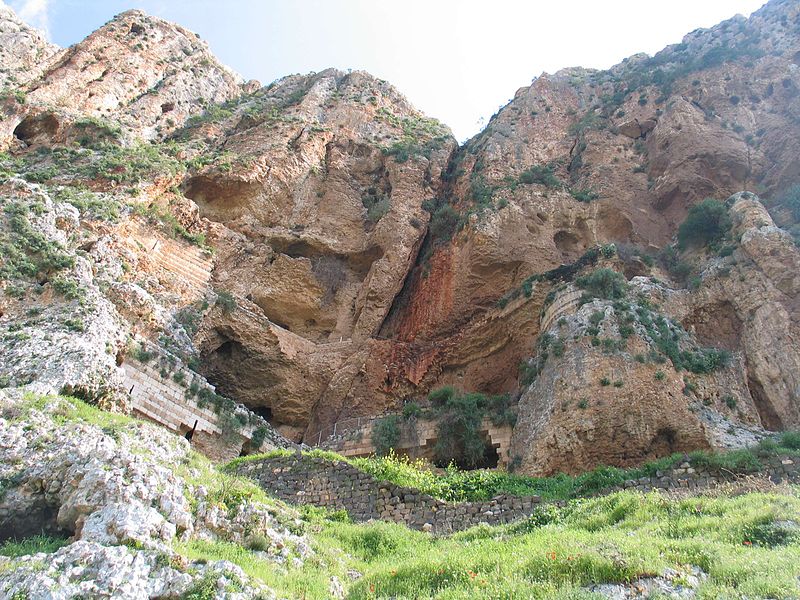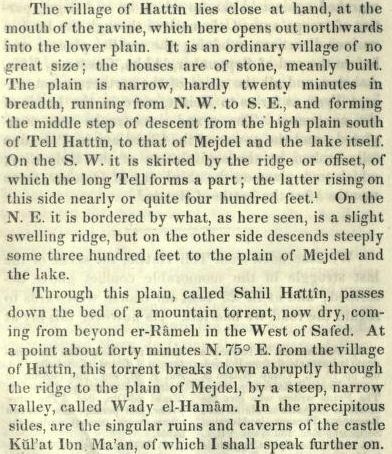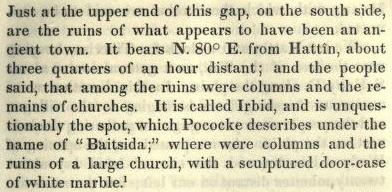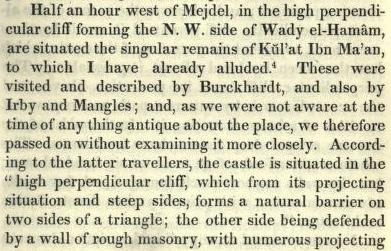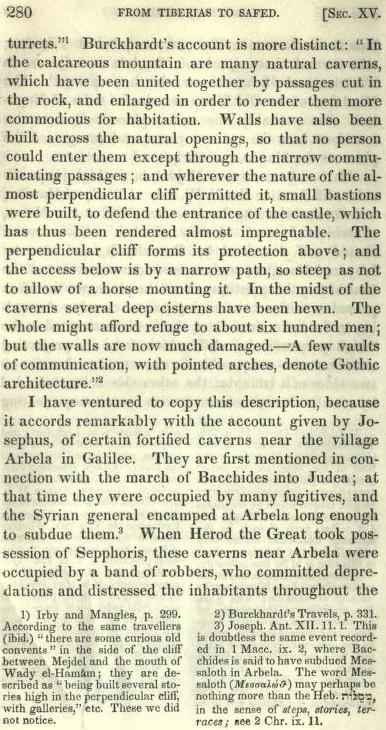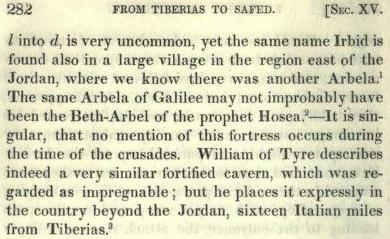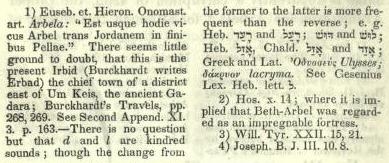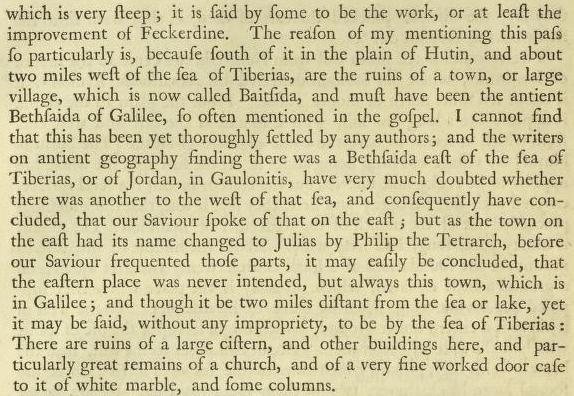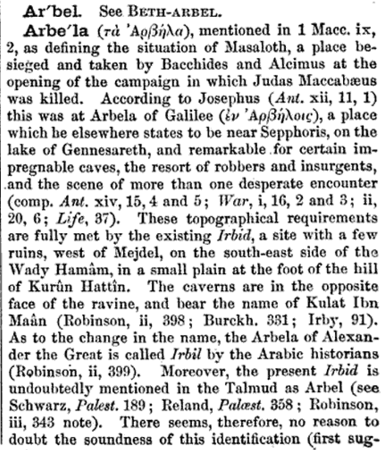|
Other Archaeological Sites / The Neolithic of the Levant (500 Page Book Online)
Modern Arabic Irbid in Northern Jordan --- Canaanite Arabella or Arbela
Biblical Beth Arbel --- Arbila of the Decapolis
Search "Arbela" in the Perseus Digital Library: Greek and Roman Texts (Tufts University)
For the "Arbella" pertaining to Mesopotamia in northeastern Iraq
Beth Arbel (“house of Arbel”) --- An Israelite town devastated by a certain Shalman (Shalmaneser) in Hosea 10:14 (See also Hosea in Perseus) . There is no other mention of either this town or the king in the Bible. Beth Arbel is usually identified with the modern Irbid (2) ... Irbid (Arabic: إربد) --- Artifacts and graves in the area show that Irbid was built on successive Early Bronze Age settlements. Pieces of pottery and wall stones found at [Canaanite] Tell Irbid were estimated to be made in the year 3200 B.C. It was possibly the Beth Arbel of the Bible. In the Hellenistic period (323-21 B.C.) it was a major trade center and later became the hellenized Arbila of the Decapolis from the 1st century BCE through the 2nd century CE. The area had extremely fertile soil and moderate climate. The many springs in the area -- in addition to the Yarmūk River -- provided water for the irrigation of crops. After the Muslim conquests in the 7th century it became known as Irbid (A) (B).
ENCYCLOPAEDIA JUDAICA -- Second Edition -- VOLUME 2 (2007) ARBEL (Arbela; Hebrew אְַרֵבּל ), name of two sites in Erez Israel (an additional Arbel is also known in Jordan). The first is known principally from the writings of Eusebius (Onomasticon 14:20 --- SEE Note 37 Arbēla) and was situated nine miles east of Legio in the Jezreel Valley not far from Afulah. The second and the most important site bearing this name however is situated on the west side of Lower Galilee, identified as Khirbet Irbid (Ḥorvat Arbel), to the northwest of Tiberias. The remains of an ancient Byzantine synagogue were explored at the site by Charles Wilson in the 19t century as well as fortified caves which were connected by stairways and situated at a strategic point at the entrance to the valley facing the Sea of Galilee. It is possible that Arbel may be identical with that Beth-Arbel which is mentioned in Hosea 10:14 as the site of a historic battle. The Seleucid commander Bacchides in his second campaign against Judah Maccabee captured the “mesalot (steps or ascent) at Arbel” and executed the inhabitants (I Maccabees 9:2). The reference is apparently to the caves in the vicinity and the connecting stairways. The Zealots who rose against Herod in 39 B.C.E. sought refuge in these caves. Herod routed them by lowering from the escarpment cages containing soldiers who lit fires at the entrances of the caves (Josephus Antiquities 12.420). During the Jewish War (66–70) against the Romans fortifications were built in this area (probably at Qalat ibn Maan) by Josephus, who was a local commander at that time, and he later recorded this in his writings (Life 185). After the destruction of the Second Temple priests of the House of Jeshua settled at Arbel. The valley of Arbel was also noted for its agricultural fertility.
(3) ARBE´LA in the Dictionary of Greek and Roman Geography --- William Smith Editor (1854) 2. Kŭlat Ibn Ma'an: a village in Galilee in the neighbourhood of which were certain fortified caverns. This Arbela of Galilee was probably the Beth-Arbel of the prophet Hosea (10.14). The caverns are first mentioned in connection with the march of Bacchides into Judaea; they were then occupied by many fugitives and the Syrian general encamped at Arbela long enough to make himself master of them (Flavius Josephus -- Antiquities of the Jews: 12.11.1). This is probably the same event as that recorded in 1 Maccabees 9.2 where Bacchides is said to have subdued Messaloth in Arbela; the word Messaloth (Μεσσαλώθ) probably meaning steps -- stories -- terraces. When Herod the Great took Sepphoris these caverns were occupied by a band of robbers who committed great depredations in that quarter and were with difficulty exterminated by Herod. After defeating the robbers Herod laid siege to the caverns; but as they were situated in the midst of steep cliffs overhanging a deep valley with only a narrow path leading to the entrance, the attack was very difficult. Parties of soldiers were at length let down in large boxes, suspended by chains from above, and attacked those who defended the entrance with fire and sword or dragged them out with long hooks and dashed them down the precipices (Flavius Josephus -- Antiquities of the Jews 14.15. § § 4 and 5 and Wars of the Jews 1.16. § § 2--4). The same caverns were afterwards fortified by Josephus himself during his command in Galilee against the Romans; in one place he speaks of them as the caverns of Arbela (Vita or Life § 185) and in another as the caverns near the lake of Gennesareth (Wars of the Jews 2.20.6). According to the Talmud Arbela lay between Sepphoris and Tiberias. For these reasons Robinson (See Pages 250-1 and 279-82 in 6) identifies the Arbela of Galilee and its fortified caverns with the present Kŭl'at Ibn Ma'an and the adjacent site of Mins -- now known as Irbid, a name which is apparently a corruption of Irbil, the Arabic form of Arbela.
These singular remains were first mentioned by Pococke (Pages 67-8 in 5), They have been visited and described by Irby and Mangles, who write the name Erbed (Travels Page 299). Burckhardt's account (Pages 330-1 in 7) agrees remarkably with that given by Josephus. He describes them as natural caverns in the calcareous rock with artificial passages cut in them and fortified; the whole affording refuge to about six hundred men.
(4) Pages 408-9 in A Handbook for Travellers in Syria and Palestine Part II Kul'at ibn Ma'an — Returning to Wady Hamman and continuing up the valley for 20 minutes we come to a place where the sides are formed of cliffs 600 feet in height. On the left about half-way up are extensive excavations. Some of them are placed over each other, forming different stories; and some are walled up in front, leaving doors and windows. The path to them is steep and difficult. After visiting them we pass along a narrow ledge to other and more extensive caverns to which the Arabs give the name Kul'at ibn Ma'an. It appears that there were here originally natural caves which were enlarged and united by rock-hewn doors. Walls have also been built across the openings ; and wherever the nature of the cliff permitted small bastions have been erected so that the place was rendered almost impregnable. In the midst of the caves are several cisterns to which the rainwater was conducted by little channels in the rock. The place would contain about 600 men. These are the "fortified caverns" mentioned by Josephus in connexion with the city of Arbela, whose ruins cover the height above the cliff. Bacchides, the general of Demetrius III, king of Syria, when he invaded Palestine, first encamped at Arbela and subdued those who had taken refuge in the Caves. The same event is narrated in 1 Maccabees ix 2 where the Caves are called Messaloth or " Stories ". But their principal celebrity is connected with the history of Herod the Great. When he took Sepphoris these caves were filled with bandits who were the scourges of the surrounding country. Herod marched with his army against them and after a sharp action drove the greater part across the Jordan. The rest took refuge in their stronghold, to which the king laid siege. Every attempt to scale the cliffs was defeated by the difficulty of the ascent and the desperation of the occupants. At last Herod let down soldiers in large boxes, by iron chains from the heights above, who attacked the robbers with fire and sword at the entrance of their stronghold, killing some and dragging others out with long hooks and then dashing them down the precipice. The same caverns were subsequently fortified by Josephus himself when acting against the Romans in Galilee (Vita or Life 37). On regaining the rivulet we follow it up the sublime chasm for nearly a mile and then turn up the left bank to the ruins of Irbid -- Arbela or Beth-Arbel. These ruins are on the brow of the wady and on the northern side of the plateau of Hattin. The only building of any interest among them is an old Jewish synagogue mentioned in the Talmud near Irbid and close to the slope of the Wady Hamam. Captain Wilson says he made detailed plans and drawings of it ; " but it has suffered a good deal by having been at one time converted into a mosque ".
(1) Cyclopaedia of Biblical -- Theological and Ecclesiastical Literature --- Volume 1
(1) Pages 360-1 and 773 in the Cyclopaedia of Biblical -- Theological and Ecclesiastical Literature --- Volume 1 by John McClintock (1871)
(2) Page 187 in the Zondervan Illustrated Bible Dictionary by J. D. Douglas and Merrill C. Tenney (2011)
(3) Dictionary of Greek and Roman Geography --- William Smith Editor (1854)
(4) Pages 408-9 in A Handbook for Travellers in Syria and Palestine Part II by Josiah Leslie Porter and John Murray (Firm) (1868)
(5) A Description of the East and some Other Countries --- Volume II by Richard Pococke (1745)
(6) Biblical researches in Palestine -- Mount Sinai and Arabia Petraea: a journal of travels in the year 1838 --- Volume III by Edward Robinson (1841)
(7) Travel In Syria And The Holy Land by John Lewis Burckhardt (1822)
(A) Irbid --- WikiPedia
(B) Irbid --- ©2018 Encyclopædia Britannica
ENCYCLOPAEDIA JUDAICA -- Second Edition -- VOLUME 2 (2007)
|

